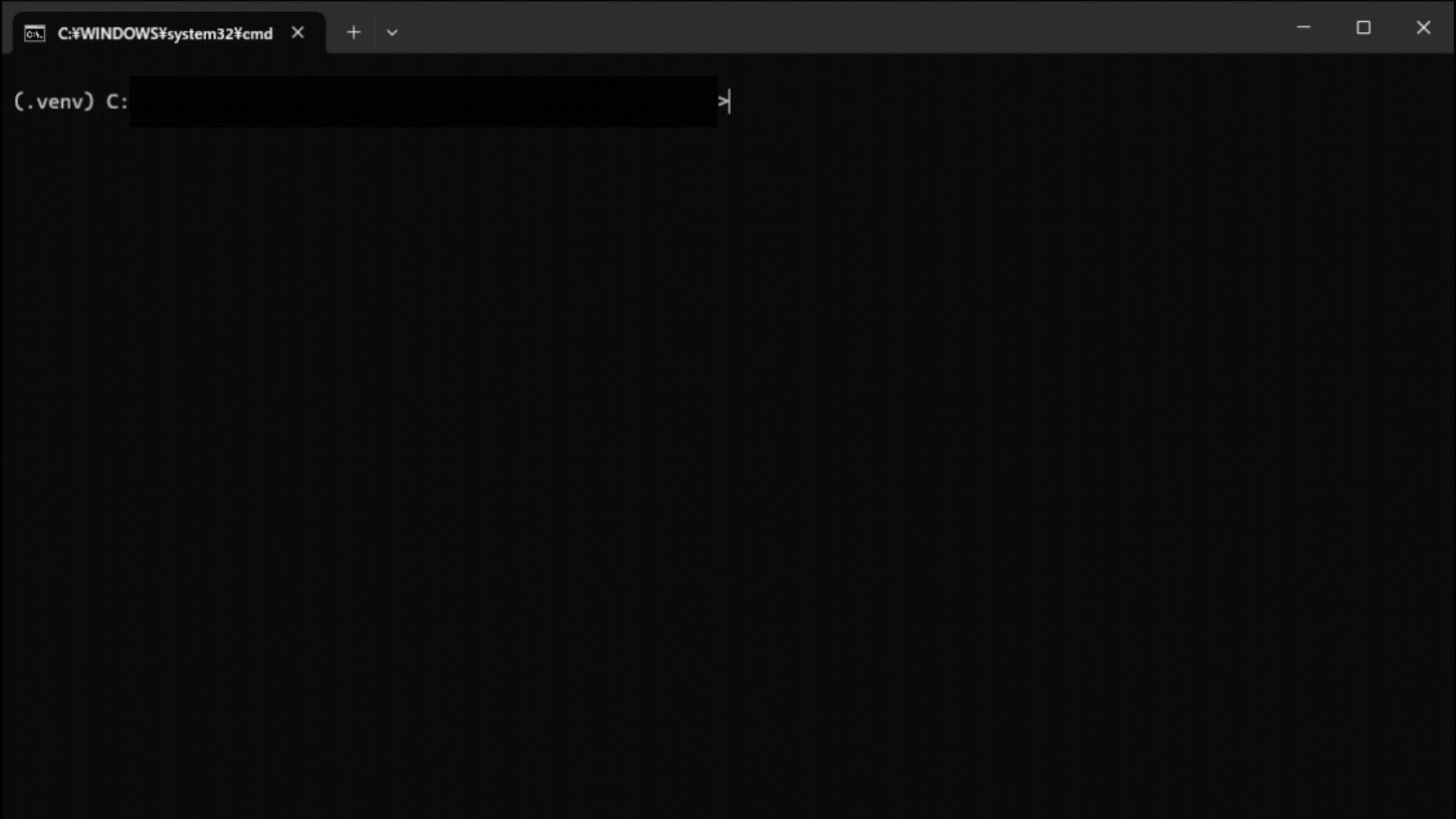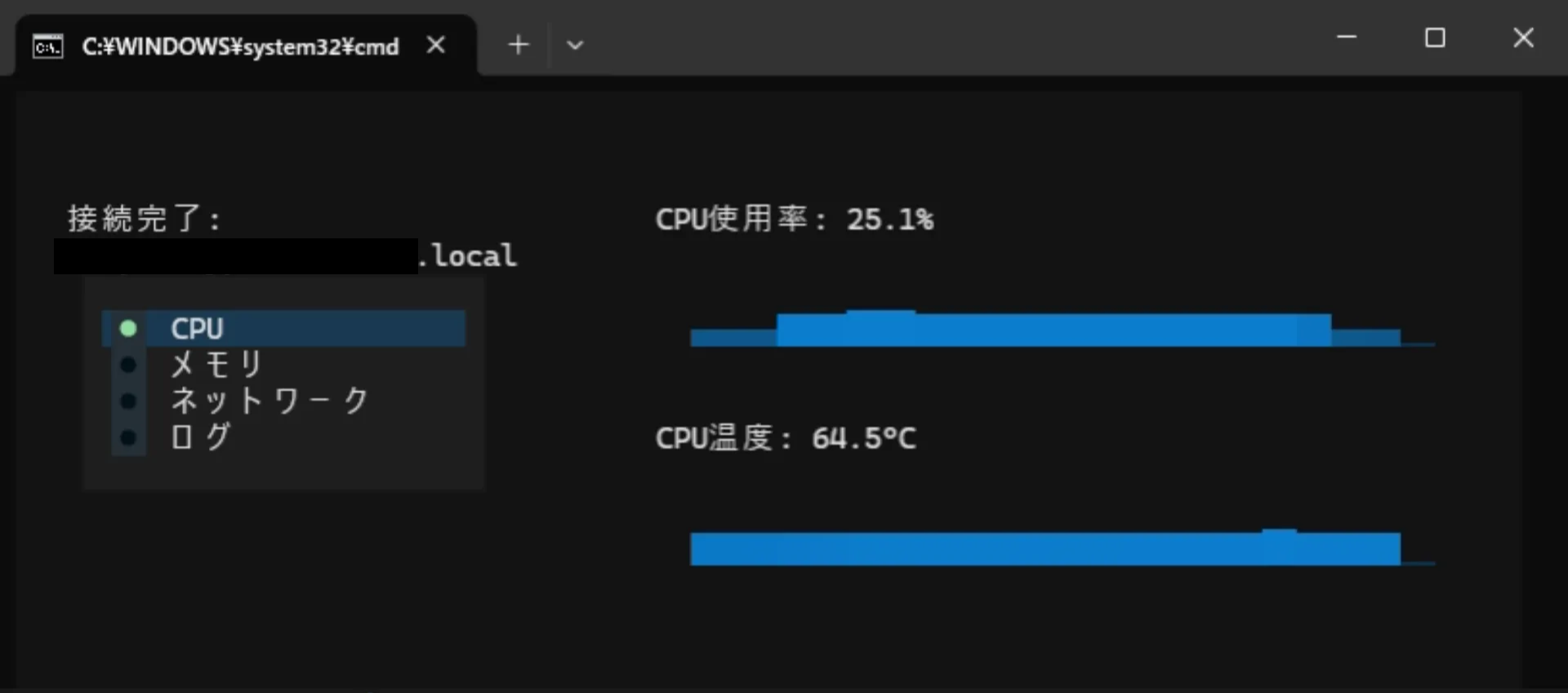1. はじめに
Raspberry Piのシステム情報を一括で視覚的に確認できたら便利だと思いTUIツールであるTextualを用いてモニターを作成しました。
この記事でわかること・対象読者
- PythonのTUIフレームワークTextualの基本的な使い方
- SSH経由でRaspberry Piの情報を取得し、PC上でモニタリングするプログラムの実装例
2. 使用技術・環境
| OS | Windows11 |
|---|---|
| 言語 | Python 3.12.0 |
| OS | Raspbian GNU/Linux 12 (bookworm) |
|---|---|
| 言語 | Python 3.11.2 |
2-1. Textual
Textualは、Python製のTUI(Text User Interface)アプリケーションを簡単に作成できるフレームワークです。GUIのようなリッチなUIをターミナル上で実現でき、ウィジェットやレイアウト、スタイル指定も柔軟です。
3. 実装
Raspberry PiとPCの公開鍵方式によるSSH接続が完了している前提として進めます。
また、本記事で紹介しているmain.pyはGitHub Gistで全文を公開しています。
3-1. ライブラリのインストール
まず、PC側でTextualをインストールします。
pip install textual
Raspberry Pi側では、システム情報取得のためにpsutilをインストールしておきます。
pip install psutil
3-2. システム情報取得スクリプト
Raspberry Pi上に~/Project/sys_info.pyというファイル名で、以下のスクリプトを配置します。CPU使用率、メモリ使用率、ディスク使用率、温度、ネットワーク送受信量をJSON形式で出力します。
import psutil
import json
import subprocess
def get_temp():
out = subprocess.check_output(["vcgencmd", "measure_temp"]).decode()
return float(out.replace("temp=", "").replace("'C\n", ""))
def get_network_data():
net_io = psutil.net_io_counters()
return {
"bytes_sent": net_io.bytes_sent,
"bytes_recv": net_io.bytes_recv,
}
net_data = get_network_data()
info = {
"cpu": psutil.cpu_percent(interval=1),
"mem": psutil.virtual_memory().percent,
"disk": psutil.disk_usage("/").percent,
"temp": get_temp(),
"net_bytes_sent": net_data["bytes_sent"],
"net_bytes_recv": net_data["bytes_recv"],
}
print(json.dumps(info))
3-3. ファイル転送
作成したスクリプトをPCからRaspberry Piへ転送するには、scpコマンドが便利です。
-
-iで秘密鍵を指定 - ユーザー名とホスト名は環境に合わせて変更します
scp -i your_key sys_info.py raspi_user_name@raspi_host_name.local:~/Project/sys_info.py
3-4. Textualアプリのウィジェット構成
Textualでは、UIを「ウィジェット」として組み立てます。以下は主要なウィジェットの配置例です。左側にラジオボタン、右側に各情報のSparklineを表示しています。
def compose(self) -> ComposeResult:
with Horizontal():
with Vertical(classes="left-panel"):
yield self.connection_label
with RadioSet():
yield RadioButton("CPU", value=True, id="radio_cpu")
yield RadioButton("メモリ", id="radio_memory")
yield RadioButton("ネットワーク", id="radio_network")
with Vertical(classes="right-panel"):
with Vertical(id="cpu_container"):
yield self.cpu_usage_label
yield self.cpu_sparkline
yield self.cpu_temp_label
yield self.temp_sparkline
with Vertical(id="memory_container"):
yield self.memory_label
yield self.memory_sparkline
with Vertical(id="network_container"):
yield self.net_up_label
yield self.net_up_sparkline
yield self.net_down_label
yield self.net_down_sparkline
3-5. SSH接続とデータ取得
PCからRaspberry Piへasyncsshで非同期SSH接続し、先ほどのスクリプトをリモート実行して情報を取得します。
async def monitor_system(self):
host = HOST_NAME
user = USER_NAME
key_path = KEY_PATH
try:
async with asyncssh.connect(
host,
username=user,
client_keys=[key_path],
known_hosts=None
) as conn:
self.connection_label.update(f"接続完了: {host}")
3-6. メインループとUI更新
1秒ごとにRaspberry Pi上のスクリプトを実行し、取得したデータでUIを更新します。
while True:
try:
result = await conn.run("python3 ~/Project/sys_info.py", check=True)
data = json.loads(result.stdout)
# CPU使用率
cpu_usage = float(data.get('cpu', 0))
self.cpu_readings.append(cpu_usage)
self.cpu_sparkline.data = list(self.cpu_readings) + [0] # 表示調整のため0を追加
self.cpu_usage_label.update(f"CPU使用率: {cpu_usage}%")
# ...他の項目も同様に更新...
except Exception as e:
self.connection_label.update(f"データ取得エラー: {e}")
await asyncio.sleep(1) # 更新間隔
3-7. レイアウト・スタイルの適用
最後に、レイアウトを整えて完成です。TextualはCSSライクなスタイル指定が可能で、ウィジェットにはそれぞれidとclassを設定できます。
CSS = """
Screen { align: center top; }
Sparkline { width: 100%; margin: 2; }
/* ...省略... */
"""
# または .tcss ファイルに記述し、CSS_PATHで指定
CSS_PATH = "style.tcss"
4. おわりに
Textualを用いて簡単にTUIアプリケーションを作成することができました。ドキュメントが充実していて、公式サイトやGitHubのサンプルを参考にしながら、直感的にUIを組み立てられる点がよかったです。
5. 参考にしたサイト等

